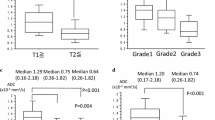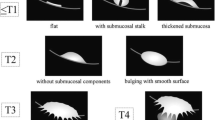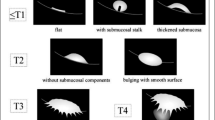Abstract
Purpose
To investigate the efficacy of diffusion-weighted MRI (DWI) in differentiating recurrent tumor from chronic inflammation and fibrosis after cystectomy or transurethral resection of bladder cancer.
Methods
Eleven patients with suspected tumor recurrence underwent pelvic DWI and dynamic contrast-enhanced (DCE) MRI at 3 months to 7 years following bladder cancer resection. The diagnosis was histologically confirmed in all patients by transurethral or cystoscopic resection of 27 lesions within 2 weeks of MR examinations.
Results
The accuracies, sensitivities, specificities, and positive predict values of DWI (92.6%, 100%, 81.8%, and 88.9%) were higher than those of DCE MRI (59.3%, 81.3%, 27.3%, and 54.2%) for detecting recurrent tumors. Using receiver operating characteristic analysis, the accuracy of DWI was significantly higher than that of DCE MRI (P < 0.05). There was no significant difference between DWI diagnosis and histopathology (P > 0.05), whereas the difference between diagnosis of DCE MRI and histopathology was significant (P < 0.05). The normalized apparent diffusion coefficients of recurrent tumors (0.697 ± 0.219) were significantly (P < 0.05) lower than those of postoperative inflammation or fibrosis (1.019 ± 0.143).
Conclusions
DWI is superior to DCE MRI for differentiating recurrent bladder tumors from postoperative inflammation or fibrosis. DWI can be included in the follow-up MRI protocol after bladder cancer surgery.





Similar content being viewed by others
References
Saad A, Hanbury DC, McNicholas TA, et al. (2002) A study comparing various noninvasive methods of detecting bladder cancer in urine. BJU Int 89:369–373
Tuncbilek N, Kaplan M, Altaner S, et al. (2009) Value of dynamic contrast-enhanced MRI and correlation with tumor angiogenesis in bladder cancer. AJR Am J Roentgenol 192:949–955
Slaton JW, Swanson DA, Grossman HB, Dinney CP (1999) A stage specific approach to tumor surveillance after radical cystectomy for transitional cell carcinoma of the bladder. J Urol 162:710–714
Solsona E, Iborra I, Rubio J, et al. (2003) Late oncological occurrences following radical cystectomy in patients with bladder cancer. Eur Urol 43:489–494
Padhani AR, Liu G, Koh DM, et al. (2009) Diffusion-weighted magnetic resonance imaging as a cancer biomarker: consensus and recommendations. Neoplasia 11:102–125
El-Assmy A, Abou-El-Ghar ME, Refaie HF, Mosbah A, El-Diasty T (2012) Diffusion-weighted magnetic resonance imaging in follow-up of superficial urinary bladder carcinoma after transurethral resection: initial experience. BJU Int 110:E622–E627
Takeuchi M, Sasaki S, Ito M, et al. (2009) Urinary bladder cancer: diffusion-weighted MR imaging—accuracy for diagnosing T stage and estimating histologic grade. Radiology 251:112–121
Abou-El-Ghar ME, El-Assmy A, Refaie HF, El-Diasty T (2009) Bladder cancer: diagnosis with diffusion-weighted MR imaging in patients with gross hematuria. Radiology 251:415–421
Watanabe H, Kanematsu M, Kondo H, et al. (2009) Preoperative T staging of urinary bladder cancer: does diffusion-weighted MRI have supplementary value? AJR Am J Roentgenol 192:1361–1366
Rosenkrantz AB, Mussi TC, Spieler B, et al. (2012) High-grade bladder cancer: association of the apparent diffusion coefficient with metastatic disease: preliminary results. J Magn Reson Imaging 35:1478–1483
Papalia R, Simone G, Grasso R, et al. (2012) Diffusion-weighted magnetic resonance imaging in patients selected for radical cystectomy: detection rate of pelvic lymph node metastases. BJU Int 109:1031–1036
Yoshida S, Koga F, Kawakami S, et al. (2010) Initial experience of diffusion-weighted magnetic resonance imaging to assess therapeutic response to induction chemoradiotherapy against muscle-invasive bladder cancer. Urology 75:387–391
Matsuki M, Inada Y, Tatsugami F, et al. (2007) Diffusion-weighted MR imaging for urinary bladder carcinoma: initial results. Eur Radiol 17:201–204
Qayyum A (2009) Diffusion-weighted imaging in the abdomen and pelvis: concepts and applications. Radiographics 29:1797–1810
Lim KS, Tan CH (2012) Diffusion-weighted MRI of adult male pelvic cancers. Clin Radiol 67:899–908
DeLano MC, Cooper TG, Siebert JE, Potchen MJ, Kuppusamy K (2000) High-b-value diffusion-weighted MR imaging of adult brain: image contrast and apparent diffusion coefficient map features. AJNR Am J Neuroradiol 21:1830–1836
Mulkern RV, Barnes AS, Haker SJ, et al. (2006) Biexponential characterization of prostate tissue water diffusion decay curves over an extended b-factor range. Magn Reson Imaging 24:563–568
Thoeny HC, De Keyzer F, Oyen RH, Peeters RR (2005) Diffusion-weighted MR imaging of kidneys in healthy volunteers and patients with parenchymal diseases: initial experience. Radiology 235:911–917
Bilgili Y, Unal B (2004) Effect of region of interest on interobserver variance in apparent diffusion coefficient measures. AJNR Am J Neuroradiol 25:108–111
Ulug AM, Beauchamp N Jr, Bryan RN, van Zijl PC (1997) Absolute quantitation of diffusion constants in human stroke. Stroke 28:483–490
Lim HK, Kim JK, Kim KA, Cho KS (2009) Prostate cancer: apparent diffusion coefficient map with T2-weighted images for detection—a multireader study. Radiology 250:145–151
Author information
Authors and Affiliations
Corresponding author
Rights and permissions
About this article
Cite this article
Wang, Hj., Pui, M.H., Guo, Y. et al. Diffusion-weighted MRI in bladder carcinoma: the differentiation between tumor recurrence and benign changes after resection. Abdom Imaging 39, 135–141 (2014). https://doi.org/10.1007/s00261-013-0038-0
Published:
Issue Date:
DOI: https://doi.org/10.1007/s00261-013-0038-0




